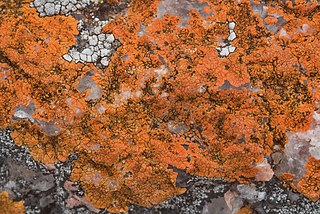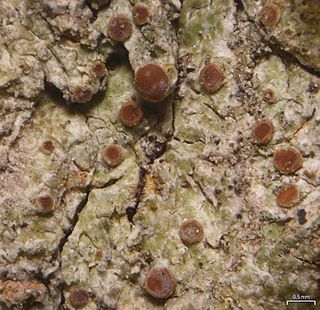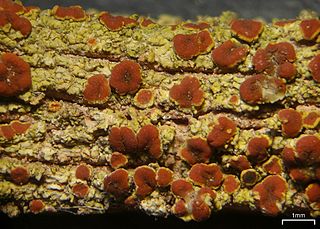
The Teloschistaceae are a large family of mostly lichen-forming fungi belonging to the class Lecanoromycetes in the division Ascomycota. Many members of the Teloschistaceae are readily identifiable by their vibrant orange to yellow hue, a result of its frequent anthraquinone content. The presence of these anthraquinone pigments, which confer protection from ultraviolet light, enabled this group to expand from shaded forest habitats to harsher environmental conditions of sunny and arid ecosystems during the Late Cretaceous. Collectively, the family has a cosmopolitan distribution, although members occur predominantly in subtropical and temperate regions. Although most members either live on rock or on bark, about 40 species are lichenicolous–meaning they live on other lichens.
Neobrownliella brownlieae is a species of saxicolous (rock-dwelling), crustose lichen in the family Teloschistaceae. It is widely distributed in Australia.
Caloplaca durietzii, or Durietz's orange lichen, a smooth surfaced yellowish orange crustose areolate lichen with elongated lobes that grows on wood or bark in southwestern North America. It is commonly seen growing on old junipers in Joshua Tree National Monument in the Mojave Desert. It is in the Caloplaca fungus genus of the Teloschistaceae family.

Gyalolechia is a genus of lichen-forming fungi belonging to the family Teloschistaceae. It contains 18 species of crustose lichens.
Apatoplaca is a fungal genus in the family Teloschistaceae. It is monotypic, containing a single species, the rare crustose lichen Apatoplaca oblongula, found in the United States.
Huneckia is a genus of crustose lichens in the subfamily Caloplacoideae of the family Teloschistaceae. It has four species.
Gallowayella aphrodites is a species of corticolous (bark-dwelling), foliose (leafy) lichen in the family Teloschistaceae. It is found in the Mediterranean countries Greece, Cyprus, and Italy. Characteristics of the lichen include its small thallus, the disposition of the rhizines on the thallus undersurface, and the lack of vegetative propagules.
Neobrownliella is a genus of crustose lichens in the subfamily Teloschistoideae of the family Teloschistaceae. It has five species. The genus was circumscribed in 2015 by lichenologists Sergey Kondratyuk, Jack Elix, Ingvar Kärnefelt, and Arne Thell, with Neobrownliella brownlieae assigned as the type species. It is a segregate of the large genus Caloplaca. Characteristics of Neobrownliella include a thallus that is continuous or areolate, the presence of anthraquinones as lichen products, a cortical layer with a palisade paraplectenchyma, and the lack of a thick palisade cortical layer on the underside of the thalline exciple. Two species were included in the original circumscription of the genus; an additional three species were added in 2020.

Wetmoreana is a genus of lichen-forming fungi in the family Teloschistaceae. It has two crustose, saxicolous (rock-dwelling) species.

Fulgogasparrea appressa is a species of saxicolous (rock-dwelling), crustose lichen in the family Teloschistaceae. It has a widespread distribution in western Mexico, including Baja California. It is characterized by its vibrant colors, unique shape, and specific habitat preferences.

Niorma is a genus of lichen-forming fungi in the family Teloschistaceae. It has six fruticose species, with N. derelicta assigned as the type species. The genus was originally proposed by Italian lichenologist Abramo Bartolommeo Massalongo in 1861, but this and several other genera he proposed were largely ignored by later contemporaries. As part of a molecular phylogenetics-led restructuring of the teloschistoid clade of the subfamily Xanthorioideae in the Teloschistaceae, Sergey Kondratyuk and colleagues resurrected the genus for use about 150 years later. Genus Niorma comprises what was previously known as a species complex centred around the taxon previously known as Teloschistes hypoglaucus.
Caloplaca nigra is a species of saxicolous (rock-dwelling), crustose lichen in the family Teloschistaceae. Found on rocks predominantly in the Galápagos Islands, it is characterised by its dark reproductive structures.
Elixjohnia is a genus of lichen-forming fungi in the family Teloschistaceae. It has four species of saxicolous (rock-dwelling), crustose lichens that occur in Australasia.

Obscuroplaca is a genus of lichen-forming fungi in the family Teloschistaceae. It contains three species of corticolous (bark-dwelling), crustose lichens.

Opeltia is a genus of lichen-forming fungi in the family Teloschistaceae. It has four species of corticolous (bark-dwelling), crustose lichens.
Solitaria is a fungal genus in the family Teloschistaceae. It contains a single species, the corticolous (bark-dwelling), crustose lichen Solitaria chrysophthalma.
Caloplaca aseptatospora is a species of corticolous (bark-dwelling), crustose lichen in the family Teloschistaceae. Found in Australia, it was formally described as a new species in 2009 by lichenologists Sergey Kondratyuk and Ingvar Kärnefelt. The type specimen, collected from Coochiemudlo Island in 1982 by Rex Filson, was found growing on the base of a sheltered tree trunk. The species epithet alludes to its main diagnostic character–largely immature, non-septate spores. Caloplaca aseptatospora is only known to occur in a few localities in Queensland.
Caloplaca bartlettii is a species of saxicolous (rock-dwelling), crustose lichen in the family Teloschistaceae. It is found in Tasmania and New Zealand, where it grows on coastal rock outcrops.

Erichansenia is a genus of lichen-forming fungi in the family Teloschistaceae. It has three species of saxicolous (rock-dwelling), crustose lichens.
Calogaya alaskensis is a species of crustose lichen in the family Teloschistaceae. It was first described as new to science in 2004 by Clifford Wetmore, who placed it in the genus Caloplaca. Ulf Arup and colleagues transferred the taxon to Calogaya in 2013 following a molecular phylogenetics-led restructuring of the Teloschistaceae.







